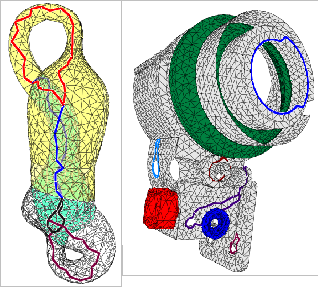Imagine Internships
Topology preserving simplification

1- and 2-cycles on two non-manifold mesh models [2]
Advisors
Jean-Claude Leon, IMAGINE teamFranck Hetroy, Morpheo team
E-mail : Jean-Claude.Leon@grenoble-inp.fr
Tel.: 04 56 52 71 05
E-mail : Franck.Hetroy@imag.fr
Tel.: 04 76 61 55 04
Context
This project is part of a multi-disciplinary and international partnership with the Inria ALICE team in Nancy and the university of Genova, Italy, existing for several years. Its aim is to identify and extract topological properties describing non-manifold objects, in order, for instance, to process more efficiently time-dependent (4D) meshes, or to create new modelling operators in engineering applications. The internship consists in setting up a classification of non-manifold simplicial complexes to connect homological descriptors with intuitive shape configurations. To this end, homological descriptors must be obtained in a nearly interactive way. Pre-requisites include interest and skills in applied geometry (for instance, MoSIG's second year course "Computational Geometry").
Objectives
Many applications use 3D objects modelled using volume, surface and line sub domains connected together in many different ways. Extracting global topological properties is a first step that has been robustly achieved using constructive homology [1, 2] of simplicial complexes. Examples of such objects include time-varying meshes [5], as used in computer vision and computer graphics, or Finite Element meshes used in mechanical engineering, etc.
Gaining global topological properties is an important step but it is not sufficient since k-cycles [1, 2], are not always easy to interpret as shape features (see the images above). The final purpose of this project is to establish a connection between k-cycles and shape features [4] so that topological properties can be easily understood and processed for a large range of applications. To do so, the idea is to simplify each component of a topology-based decomposition [3] of the input simplicial complex in a clever way, such that the evaluation of the homological features [2] both becomes nearly interactive and leads to an automatic classification of shape features.
New attributes, e.g. time, are foreseen to complement the data structures so that a larger range of applications can be addressed and illustrated.
Development will be carried out in C++; a common software developed with the university of Genova is the basic building block that will be available to start with.
Keywords
Non-manifold object, topology, homology, simplicial complex, shape feature.References
[1] M. K. Agoston, "Computer graphics and geometric modelling: Mathematics", Springer, 2005.[2] D. Boltcheva, D. Canino, S. Merino Aceituno, J-C. Léon, L. De Floriani, F. Hétroy, "An iterative algorithm for homology computation on simplicial shapes", Computer-Aided Design (Proc. of SPM, Orlando, October 25-27), Elsevier, 2011.
[3] A. Hui, L. de Floriani, "A two-level topological decomposition for non-manifold simplicial shapes", Solid and physical modelling conference 2007, Beijing, June 2007.
[4] J-C. Leon, L. de Floriani, "Contribution to a taxonomy of non-manifold models based on topological properties", Proc. of ASME IDETC Int. Conf., New-York, August 3-6, 2008.
[5] A. Zaharescu, E. Boyer, R. Horaud, "TransforMesh: a topology-adaptive mesh-based approach to surface evolution", Proc. of 8th Asian Conference on Computer Vision (ACCV) , 2007. http://mvviewer.gforge.inria.fr/
